Craving a taste of Italy’s Ligurian coast? Dive into Authentic Focaccia Genovese, a centuries-old bread recipe requiring only 4 simple ingredients. Experience the magic of Italian tradition with every bite of this soft, olive-oil-rich delight!
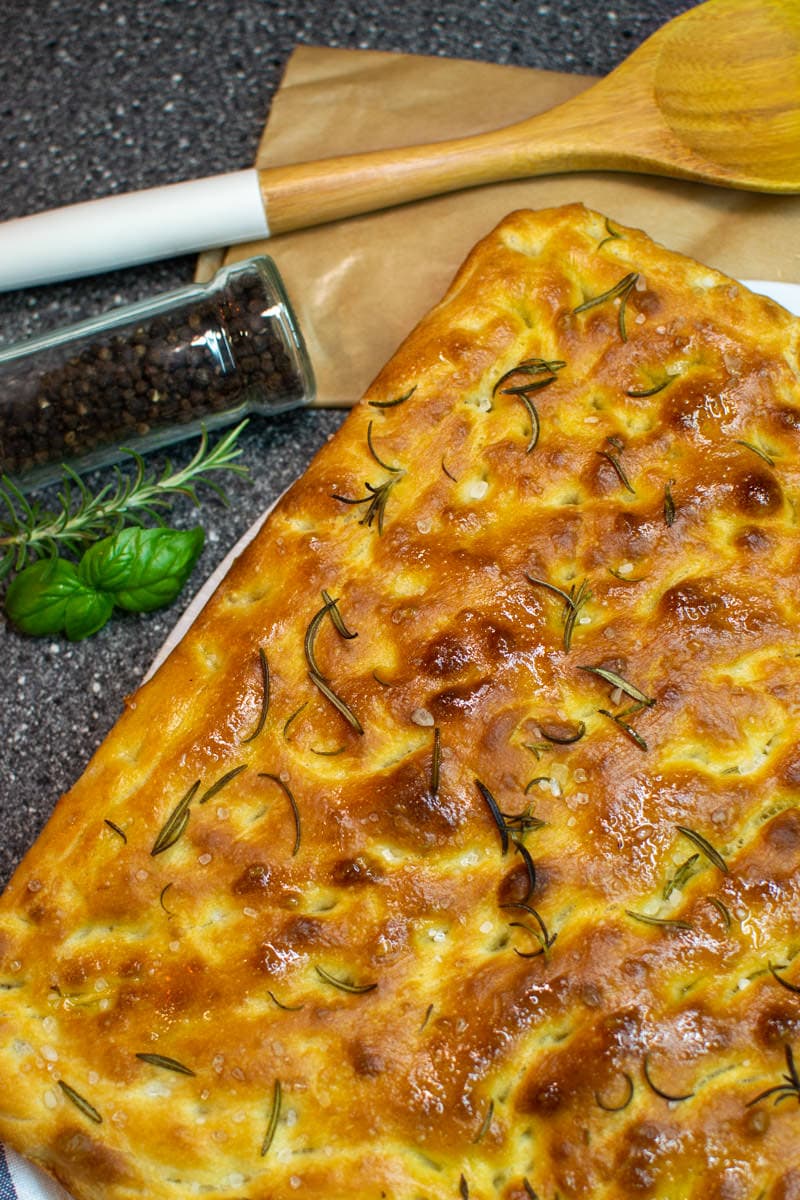
If you’re a fan of Italian cuisine, you’re in for a treat! Authentic Italian Focaccia made from only 4 ingredients is a beloved classic that has captured the hearts and taste buds of food enthusiasts around the world.
This delectable flatbread is a true masterpiece, known for its soft and spongy interior, perfectly crisp exterior, and a burst of authentic Italian flavor in every bite. What’s even more enticing is that you can create this culinary delight with just 4 simple ingredients: All-purpose flour, powdered sugar, yeast, and rosemary.
To achieve that unmistakable Italian taste and texture, two key elements play a pivotal role: extra virgin olive oil and large coarse sea salt. These ingredients are not just toppings; they’re the secret behind the magic.
The generous coating of extra virgin olive oil infuses the bread with a rich, fruity aroma, while the coarse sea salt adds a delightful crunch and a burst of savory goodness. Together, they transform a humble bread into a culinary work of art.
If you’re aiming for the softest, most tender focaccia, here’s a tip: go easy on the yeast. While yeast is necessary for the dough to rise, using a minimal amount will give you that sought-after fluffy interior without overwhelming the delicate flavor.
And if you find yourself short on time during the day, worry not! You can prepare the focaccia dough the night before, allowing it to rise slowly and develop its complex flavors overnight, so you can wake up to a baking adventure the next day.
Get ready to embark on a journey to the heart of Italy with this Authentic Italian Focaccia recipe that promises simplicity and perfection in every bite.
🤩 Why You Will Love This Recipe?
- You only need a few ingredients to make it.
- It will take you less than an hour.
- If you like crispy bread, this recipe is a perfect fit for you.
- If you’re tired of the same sandwiches, replace the bread with focaccia, and you will get a new taste to your sandwiches.
- It’s a simple snack to take with you when you go on trips.
🏆 Tips for Success? How to Make It Better?
- Read the yeast instructions on the package. If you use yeast that says on the package that it must be dissolved in liquid, I suggest you be careful when preparing the leaven. Because if you put the yeast in too hot water, it will die, and the dough will not grow.
- If the yeast doesn’t require to dissolve in liquids, you can mix the yeast with the rest of the dry components from this recipe. This way, you will avoid the situation of having yeast lumps that will not incorporate into the dough.
- If you have enough time, prepare the dough, preferably the night before. This way, you will get a more intense taste of the focaccia.
- Don’t be afraid to experiment with focaccia toppings because this flatbread is a very versatile base, and you can use almost any combination.
🥘 Ingredients Needed for This Recipe:
- All-Purpose Flour: This forms the base of the focaccia dough. You can substitute it with bread flour for a chewier texture, or use gluten-free flour if you’re looking for a gluten-free option.
- Extra Virgin Olive Oil: Olive oil is essential for the rich flavor and moist texture of focaccia. While there’s no exact substitute for its unique flavor, you can use other oils like vegetable or canola oil, but keep in mind it will alter the taste slightly.
- Water: Water is the liquid component that helps bind the dough. You can replace it with milk for a slightly softer texture or use a dairy-free milk like almond or soy milk for a non-dairy alternative.
- Fresh Rosemary: Fresh rosemary adds a fragrant and herbal note to your focaccia. If you don’t have fresh rosemary, you can use dried rosemary, but reduce the quantity by half since dried herbs are more concentrated in flavor.
Optionally, if you prefer a slightly sweeter version, you can add about a teaspoon of granulated sugar to the dough, but it’s not a mandatory ingredient.
🤔 Why the Dough for Focaccia Genovese Didn’t Rise?
If you tried earlier to make focaccia and the dough didn’t rise, there are a few possible reasons why this happened:
- The water you poured over the yeast was too hot. In that case, you killed the yeast from the beginning. The temperature of the water should be lower than 105°F (40°C). Ideally, it should be 100°F (38-39 °C)
- When you prepared the leaven, you didn’t feed the yeasts enough with flour or sugar.
- You let the dough rise too much without kneading it. Thus the yeasts did not have enough oxygen and suffocated.
👩🍳 Step-by-Step Instructions:
If you use yeast that needs to dissolve in liquids, the first step is to prepare the leaven. If your yeast doesn’t require dissolution, just skill this step.
Let’s get started. Take a bowl or a glass big enough, and pour in it ⅓ of a cup of warm water 100°F (38-39 °C).
Pour the yeast, a tablespoon of flour, and a tablespoon of sugar into the water. Mix well all the ingredients and leave them to rest in a shady place at room temperature.
When the composition increases in volume and obtains a dense foam on the surface, we can move on to the next step.
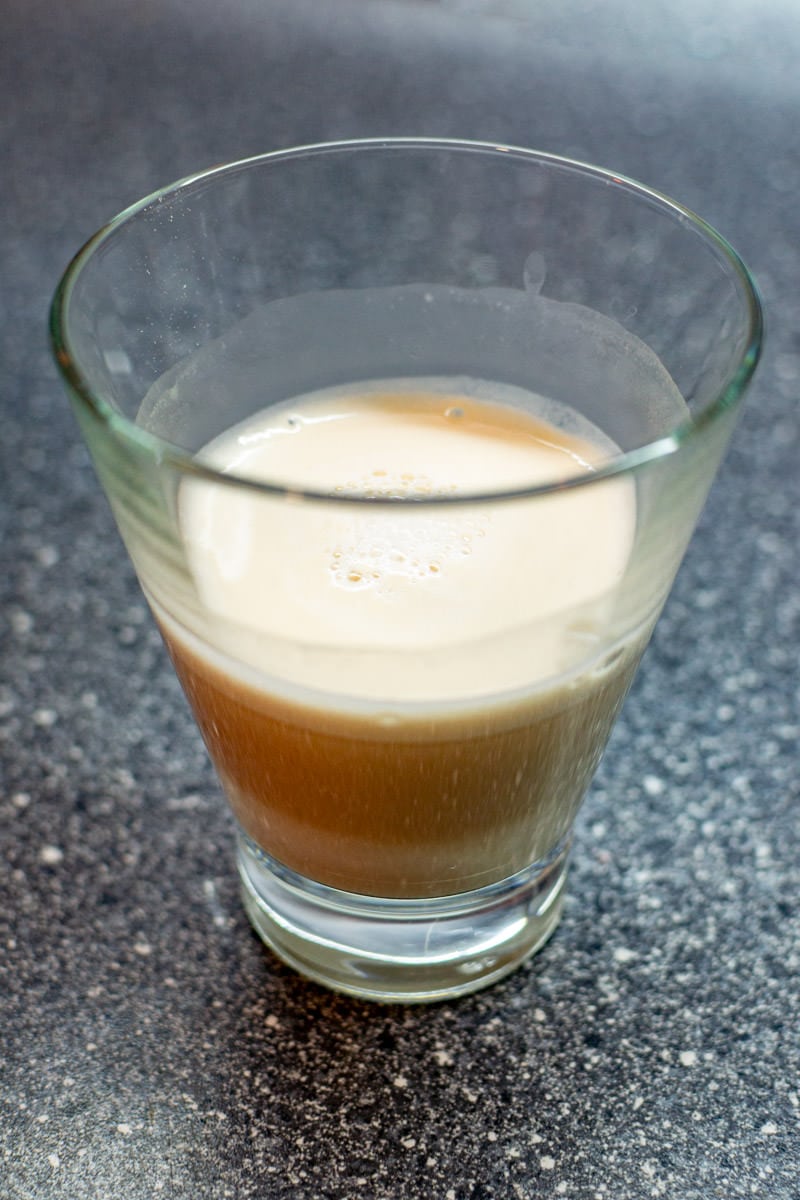
Take a big bowl, or if you will use the planetary mixer, pour the dry ingredients into the bowl of the mixer. Then pour 1 cup of water, oil, and the leaven that we just made.
If you used yeast that doesn’t require its dissolution, put all the dry ingredients in the bowl, including the yeast. Mix well, and after that, add the liquid ingredients.
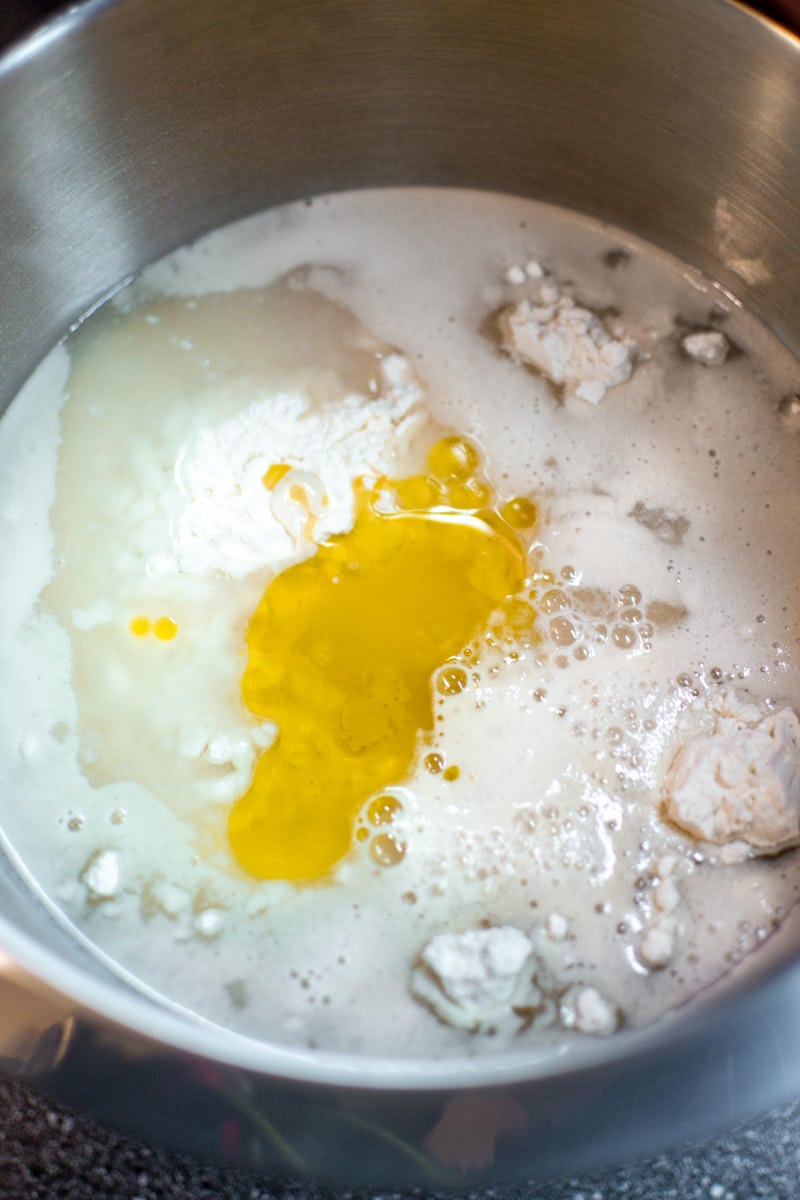
Knead the dough well.
Quick Note: If you use a food processor, then the process will take about 10 minutes. If you do this process manually, it will take you about 20 minutes.
Grease the surface of the dough with extra virgin olive oil. This will help us to avoid drying the dough until it increases in volume. After that, cover the bowl with plastic food film.
Quick Note: If you will bake the Genovese focaccia on the same day, then leave the dough at room temperature in a dark place to rise until it triples in volume. If you opt for the option to bake focaccia the next day, put the bowl covered with food film in the fridge and let it ferment overnight.
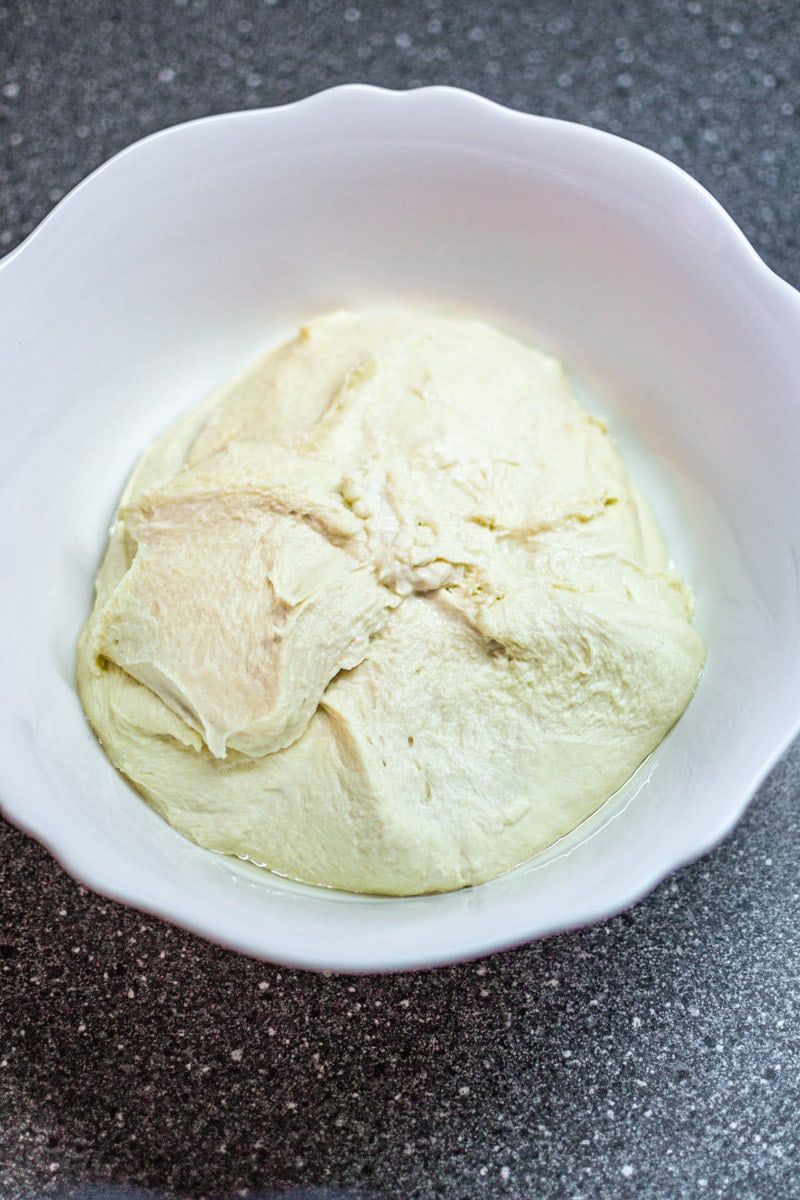
When the dough increases in volume about 3 times, take the baking tray, grease it well with olive oil, and pour the dough on the baking tray.
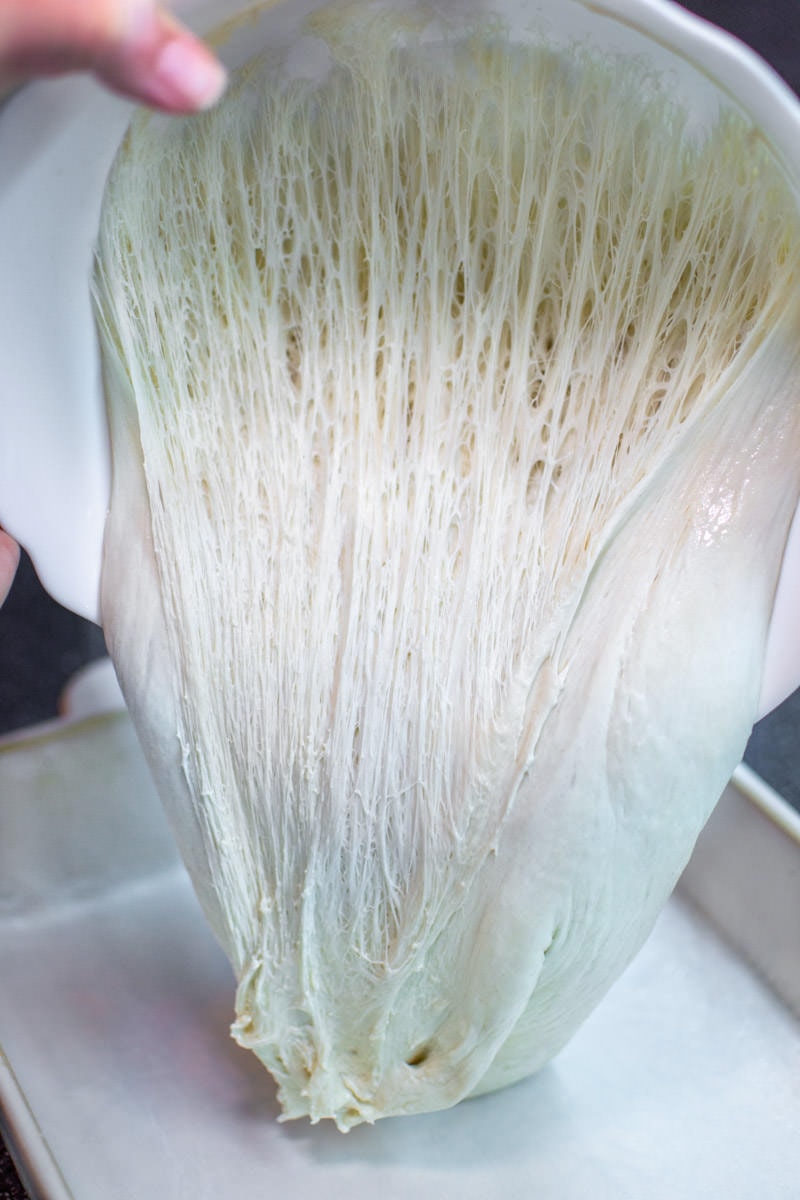
Using your hands, spread the dough evenly over the entire surface of the tray.
Grease well with olive oil and make holes in the dough with your fingers, as shown in the picture below.
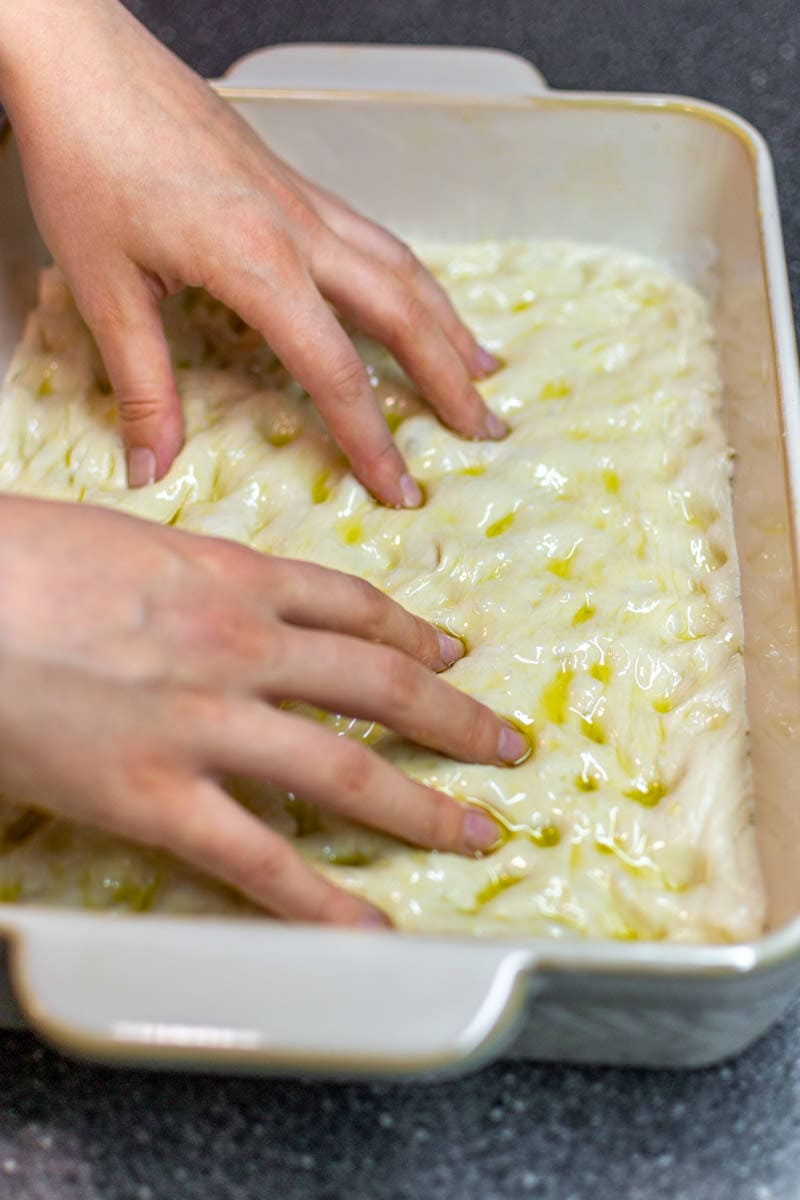
Sprinkle the surface of the dough with coarse sea salt and rosemary or other aromatic herbs that you have decided to use.
Place the tray in the preheated oven at the maximum temperature that allows your oven. Keep the focaccia inside until the top of the focaccia becomes well-browned. Baking time varies depending on the power of your oven. (This usually varies between 30-45 minutes.)
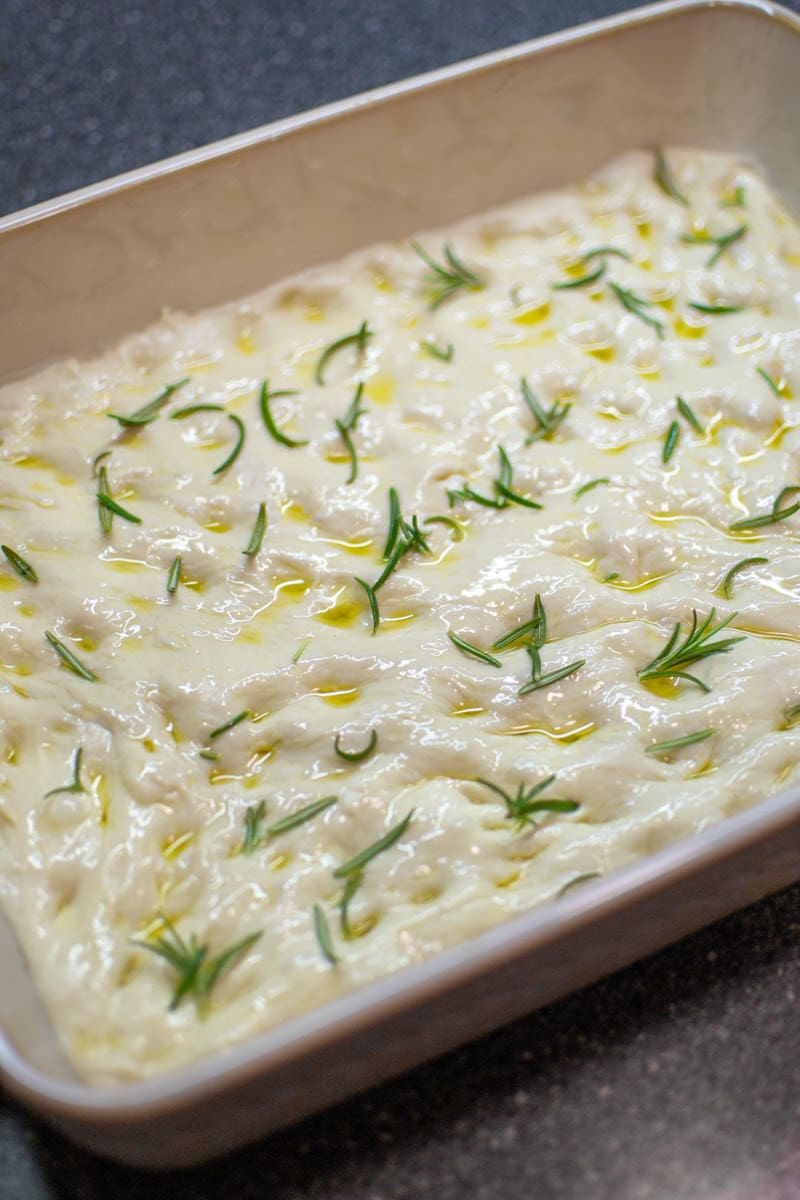
Take the focaccia out of the oven, and you can serve it as is or as bread, along with your favorite dish. Of course, it fits perfectly with any type of stew.
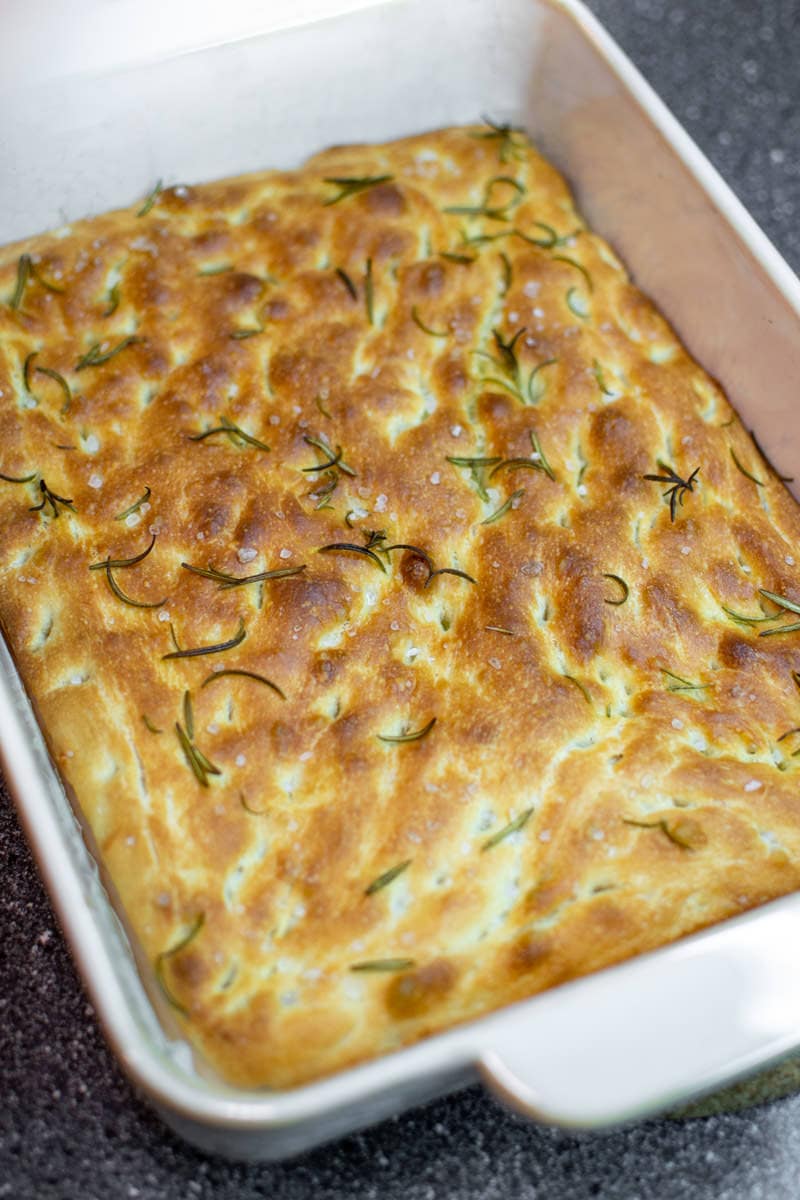
🙋 Answering Your Questions:
Is Focaccia Dough the Same as the Pizza Dough?
The difference between focaccia dough vs pizza dough is that focaccia is left to rise after the dough is flattened, while pizza is baked immediately.
Can You Make Focaccia Without Yeast?
Without the yeast, you will not get the same authentic taste because the taste and texture of the focaccia dough are actually offered by the yeast. So, if you want to get the original taste, I will recommend keeping using the yeast.
What Is the Difference Between Focaccia and Ciabatta?
They are different types of bread. The components are the same, but the proportions between water and flour are totally different. Also, the shape of the bread is different, and the method of baking differs.
How to Eat Focaccia? Hot or Cold?
Like any bread, it is tastier when it is hot. But be careful because the hot dough can cause stomach pain.
How Long Does Focaccia Last In the Fridge?
For about a week, you can keep the focaccia in the fridge in a well-closed container.
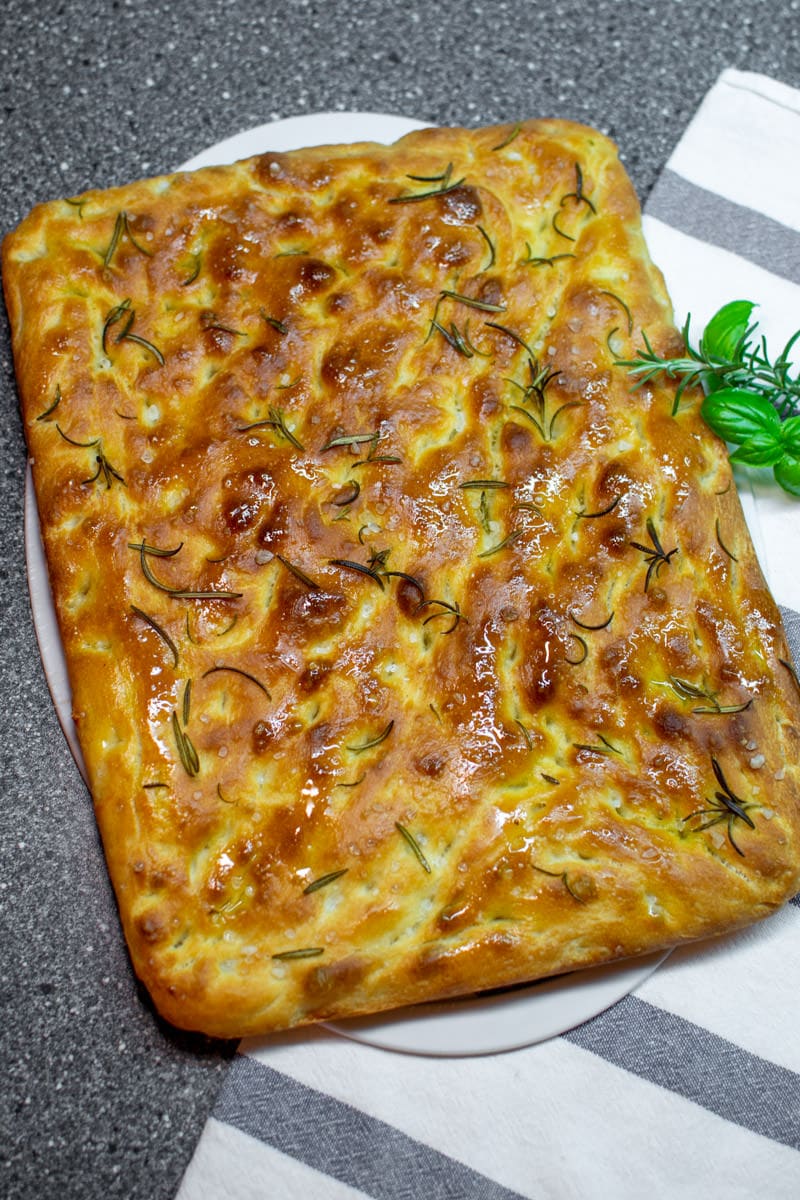
📋 Recipe Card:
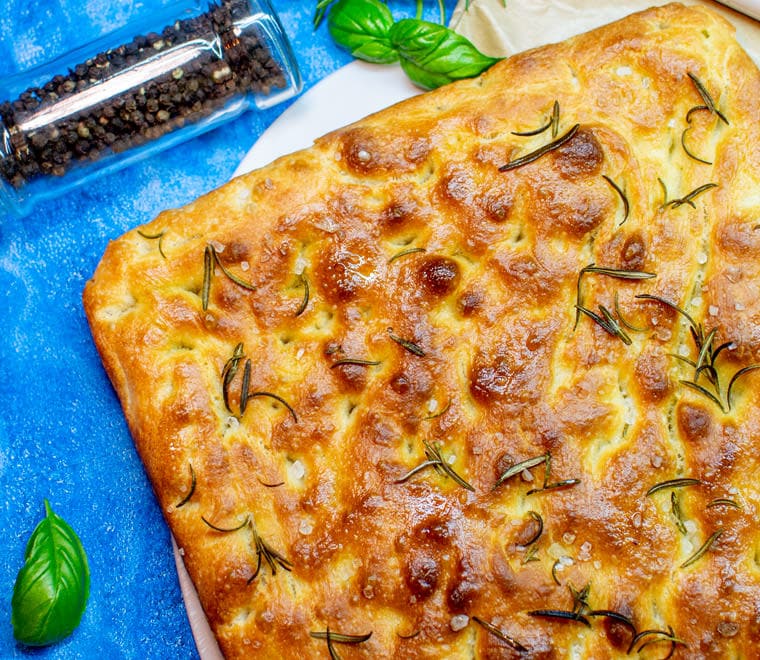
Traditional Italian Focaccia (4 ingredients)
Ingredients
For the dough:
- 4 cups All-purpose Flour
- 1 ¼ cup Water
- 2 tablespoon Olive Oil Extra Virgin
- 3 teaspoons Salt
- 2 teaspoons Sugar
- 1 ½ teaspoons Dried Active Yeast
Instructions
- Prepare the leaven if you use yeast that needs to dissolve in liquids.
- Put all the ingredients in a bowl and knead the dough well.
- Cover the dough with plastic food film and leave it to rest at room temperature until it triples in volume.
- Put the dough in the baking tray and spread it in an even layer over the entire surface of the tray.
- Grease the dough well with olive oil, make dimples in the dough with your fingers.
- Sprinkle the dough with coarse sea salt and rosemary.
- Leave the tray to rest at room temperature for about 15 minutes.
- Meanwhile, preheat the oven to maximum temperature.
- Put the traybake into the oven for 20-45 minutes. The time varies depending on the power of the oven.
- When the focaccia will become well browned, remove the tray from the oven.
Quick Note
I highly recommend reading the entire recipe to find more tips and notes about this recipe. Read Full Recipe ⇑
Notes
- If you need more detailed steps, see the basic article above.
- In the process of preparing the dough, be careful not to kill the yeast. Don’t use high temperatures.
- Don’t be afraid to experiment with focaccia toppings.

Kechi
I wish I can give this recipe post a double 5-stars! WOW, I feel so empowered to make my very first Focaccia, love the tips. Thanks for sharing.
Jill
I feel like I know everything I could possibly need to know about focaccia now! Looking forward to trying this recipe. Looks delicious!
Mahy
Oh wow, I’ve finally found a recipe that I have not tried yet. I am so excited about it!
Amy Desrosiers
This looks like the BEST bread ever! I literally pay a ton at local restaurants to pick this loaf up for meals. Now, I can make it thanks to you all!
Toni
This is so tasty! My family loved it! I would definitely make it again soon!
Gabriella
Wow! This is the first time when I’m trying to make the Italian focaccia at home and it turned out great! Really impressed by how taste it turned!
bgrmosaic
Amazing recipe! actually, I printed and will use it as a base for my next focaccia that I will make with different toppings.
Michael
This authentic Italian focaccia recipe is a game-changer! The dough was easy to work with, resulting in a perfectly fluffy and flavorful bread. The sprinkle of sea salt on top added a delightful contrast to the richness of the olive oil.
Emily
I tried making the authentic Italian focaccia, and it turned out better than I expected! The bread had a light and airy texture, and the golden crust was irresistible. The aroma of rosemary and olive oil filled my kitchen, making it hard to wait for it to cool before diving in. This recipe is a keeper for all bread lovers.
Tomasz
I think focaccia is one of the dishes that I miss the most from my trip to Rome. I just tried your recipe and it turned out soo good!
Thomas
I’m a huge fan of Italian cuisine, and this authentic focaccia recipe did not disappoint! The crust was wonderfully crispy, and the flavors were spot on. I can’t wait to make this bread again and share it with my loved ones.
Sophia
I made the authentic Italian focaccia, and it transported me straight to Italy! The soft and pillowy texture, combined with the fragrant herbs and olive oil, created a truly heavenly bread. This recipe is a gem that I’ll cherish in my kitchen.